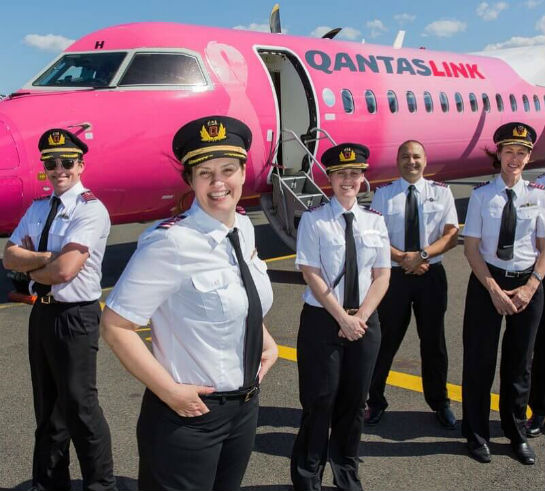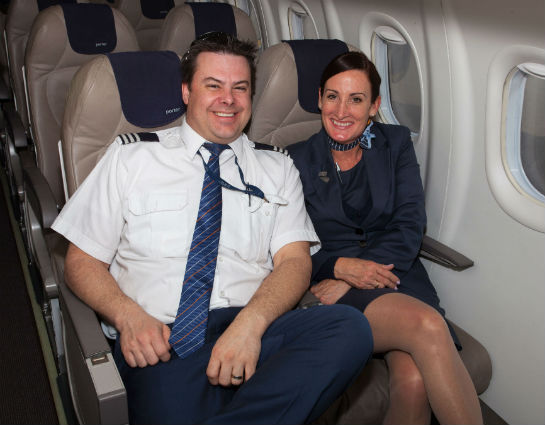Canadian pilot Susan McHaffie, second from left, is the founder of FlyPink, a breast cancer awareness campaign that encourages aviators to wear pink epaulets during the month of October. QantasLink Photo
Breast cancer has been part of Susan McHaffie’s vocabulary for as long as she can remember.
An aunt was diagnosed with the disease when McHaffie, a Canadian pilot who is now manager of fleet technical development for Australia-based QantasLink regional airline, was around 12 years old.
“It came back a couple of times at the beginning, and then she went for 18 years,” said McHaffie. “In my book that’s beating breast cancer.”
So McHaffie’s approach is not to be terrified of the disease but to help minimize its effects, raising awareness and supporting organizations that try to prevent it from taking lives.
“Early detection is one of the big, big things,” she said.
About a year and half ago, McHaffie got thinking about what the global aviation industry could do to tackle breast cancer, a disease that knows no borders.
“We all, as pilots, have friends who work at other airlines,” she said. “So how can we sort of join together as a pilot community? And you’ve got to say, one thing that identifies a pilot is their epaulets.”
McHaffie launched a campaign called FlyPink, which encourages pilots around the world to wear pink epaulets during October—Breast Cancer Awareness Month. The idea quickly took hold, finding support from thousands of pilots including some from Canadian charter operations NovaJet and Skyservice.
This year, Porter Airlines is joining the cause, the first major Canadian airline to do so.
“I thought it was going to be a slow buildup, and it hasn’t been,” said McHaffie. “It’s hit with a bang.”
Porter Airlines pilots and flight attendants will soon be able to participate in the FlyPink campaign, a grassroots effort in the global aviation community to raise funds for breast cancer research. Andy Cline Photo
Porter’s decision to join the cause came after two of its female pilots, part of a committee called Women Soar at Porter, raised the idea.
“They saw FlyPink and thought that it was something that would be great for Porter and particularly for our pilots to support,” said Brad Cicero, the airline’s director of communications and public affairs. “Breast cancer awareness is one of the things that touches a lot of people and a number of people within Porter. It’s quite common.”
Flight attendants will also be able to wear a Porter-branded breast cancer awareness pin to show their support for the program.
Wearing pink epaulets may be a subtle way of raising awareness, but Cicero expects it to spark discussions within the airline and to filter into the general airport community, to passengers and to all the locations Porter flies.
“I think it’s really about having the visibility and the ability to have people ask questions and have a conversation with people,” he said. “It may be subtle in some respects, but I think it’s the kind of thing that stands out from your ordinary flying experience.”
Wearing pink epaulets in October will likely be a voluntary measure for Porter pilots, but Cicero said he believes the majority will wear them.
“We expect that it will be a pretty enthusiastic response from our team overall,” he predicted.
About 4,500 pilots participated in FlyPink last year, in its first year. This year the goal is to have 10,000 pilots involved.
On the international front, QantasLink, Qantas International, Qantas Domestic, Network Aviation, Express Freighters Australia and Cobham Aviation Services have all participated, along with Jetconnect and Jet Star of New Zealand.
Airlines pay for the cost of the epaulets—$1.50 per pair plus shipping—and pilots donate to their national breast cancer foundation.
The campaign raised close to $100,000 worldwide in its first year. This year’s goal is $150,000, with the hope of including pilots from all across the industry.
“We want our immediate competition to join us,” said McHaffie. “It’s, how can we make this about an industry—not about a brand.”
McHaffie launched FlyPink while balancing her full-time job with QantasLink. In that first year, she and a friend spent 10 hours preparing the first 3,500 epaulet packages before stock ran out. They sat on McHaffie’s couch, watching cooking shows on T.V. and wrapping sets of epaulets with elastic bands.
“We did take a break for lunch,” she said.
McHaffie could imagine what the campaign would look like in the end, and that was what drove her.
“You picture the announcement at the end of October of how much has been raised,” she said. “You picture walking through an airport and seeing people you’ve never met before, wearing pink epaulets.
“From Day One, I could picture where it would be—or where it could be, I guess, is probably more accurate. And that’s what becomes the motivation to make it.”










